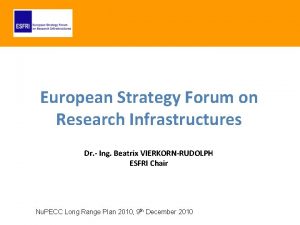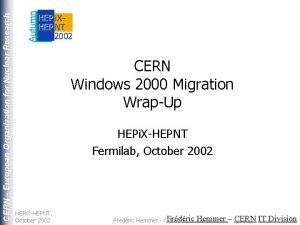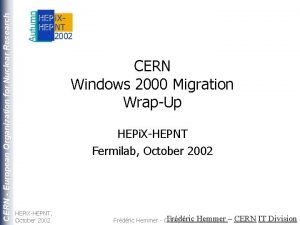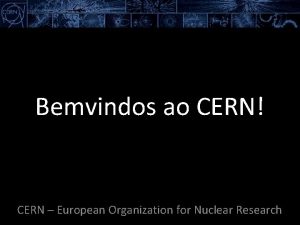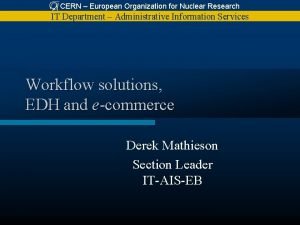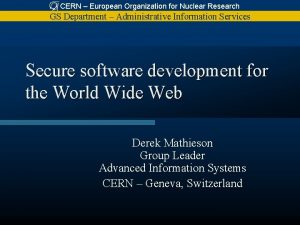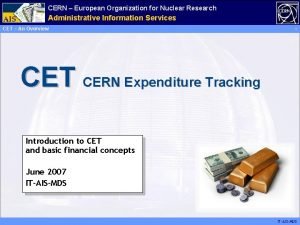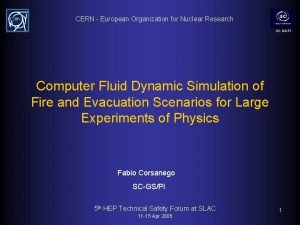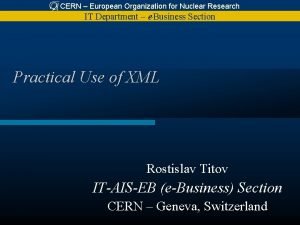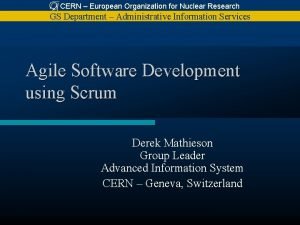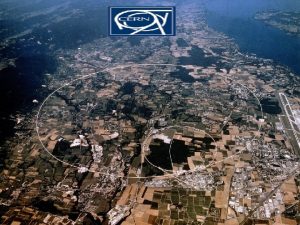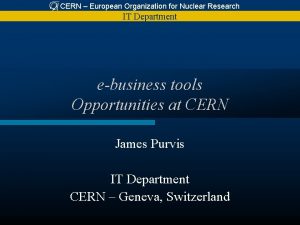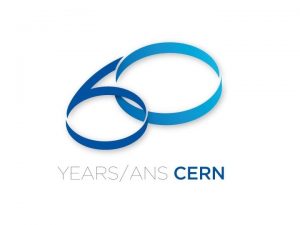CERN European Organization for Nuclear Research International Organization

















- Slides: 17

CERN, European Organization for Nuclear Research International Organization Committee: Diego Alvarez Feito - Francois Boyer - Andrea Catinaccio (CERN-EP-DT) Michael Guinchard (CERN-EN-MME) - Eric Anderssen (LBNL) 1

https: //indico. cern. ch/event/736952/ – Workshop on carbon fibre composite materials and their use in high energy physics experiments. – Second event following the first Composite workshop at 2016 LBNL https: //conferences. lbl. gov/event/54/ – Wide range of topics related to composites, focusing on relevant testing methods and numerical modelling techniques. – Combine hands-on sessions in fabrication and testing with computer sessions in which the participants will have access to state-of-the art simulation software (i. e. ANSYS ACP). 2

Accelerating Science and Innovation

CERN EP-DT Experimental Physics Department (EP) Detector Technologies (DT)

Detector Technologies Group Mandate The mandate of the EP-DT group comprises development, construction, operation and maintenance of particle detectors for the experiments at CERN. The group also offers a range of services and infrastructure for experiments and detector R&D. 5

Mat ion t a z i gan rix or EP-DT Detector Technologies Technology & Physics (DT-TP) Detector Development (DT-DD) Fluidic Systems (DT-FS) Detector Interface (DT-DI) The TP section promotes and manages projects on detector construction, integration and operation. The DD section leads R&D projects in several detector technologies, and runs related detector R&D facilities open to all users. The FS section develops, maintain and operates gas and cooling systems for particle detectors. Pool of project leaders that plans and coordinates projects established in collaboration with the experiments- across different functional areas. Facilities: Gas Lab, Silicon Lab, QART, Bond. Lab, DSF, Irradiation Facilities. The DI section develops and supports large and medium scale control and DAQ systems for the infrastructure of CERN experiments and laboratory control systems. The service is available to all experiments at CERN. It offers a coherent, ready-to-use deliverable, M&O support, advice and consultancy. Engineering Facilities (DT-EF) The EF section develops and maintains technology expertise and facilities for particle detector prototyping and contributes to small scale parts productions for CERN experiments. Facilities/shops are used to develop parts, prototypes, and conduct validation experiments in support of the group and projects. Contact Persons for Experiments and Projects Engineering Office (DT-EO) The EO section is in charge of mechanical design activities for CERN detector-related projects. Designers and engineers cover a wide range of disciplines in mechanical engineering, construction, and numerical simulation fields. Detector Construction & Operations (DT-CO) The CO section expertise is mechanics for particle detectors, including knowhow in detector design, prototyping, production, detector assembly, integration and testing. It represents the technical backbone of the group intervening and supporting through various detector projects the construction and operation of CERN experiments. PERSONNEL Staff, Act. Hon. Members 85 + 2 Fellows/TTE, PJAS/COAS 24 + 6 Students, Trainees/year 14 Doct, 6 Tech, 12 Trainees Projects FSU 31 Services ~180 persons

Silicon Detectors at LHC ALICE Pixel Detector ALICE Detector September 2016 LHCb VELO ALICE Strip Detector ATLAS Pixel Detector ATLAS SCT Barrel CMS Pixel Detector CMS Strip Tracker IB 7

Examples of LHC Tracker Structures • CERN has a long experience of industrial collaboration on the design and the manufacturing of composite materials for particles detectors Some internal activities of composite development Current CMS Outer Barrel Now: Implementation of a composite lab with the aim to make R&D, prototyping and final production of small parts Keep collaborating with the industry for large structures and big production Current ATLAS Inner Barrel Structure 6/7/2021 8

Examples of LHC Tracker Structures 6/7/2021 9

Projects: LHC Experiments 2016 -2025 • Support to Operation (mostly in technical stops, shutdowns) and Detector Upgrades • For the upgrades, EP-DT partners with CERN teams (WP agreements) LHCb • Up to LS 2 • Integration aspects • Sci. Fi (detector) • Velo (mechanics) • UT (integration) • RICH/TORCH • CO 2 cooling ALICE CMS ATLAS • Up to LS 2 • Integration aspects • ITS • ALICE TPC (GEM prod. ) • Up to LS 2 • Pixel (integration) • GE 1/1 (GEM prod. ) • CO 2 for Pixel • Up to LS 2 • NSW Module 0 • ATLAS AFP (controls) • LS 3 • TK (modules, engineering) • HG Calorimeter • LS 3 • ITK Pixel • HGTD • CO 2 cooling 10

Current Capabilities of the DT Composite Lab 11

EP-DT Technical Infrastructure EP-DT Composite Lab Semi-clean Room Characterization Room Building 153 Composite lab established in 2014 Area of 290 m² dedicated to composite activities Optical Tensile testing machine Chemical dissolution bench microscope Composite training Composite laboratory location Production Room Automatic cutting machine 1. 4 m x 1 m Filament Winding Room X-Winder 4 -axis filament winding machine Autoclave 2. 5 m x 1 m Impregnation of dry carbon fibres 12

EP-DT Composites Lab Manufacturing Capabilities In-house knowhow in a wide range of composites manufacturing techniques: Filament winding Prepreg Technology Vacuum Resin Transfer Moulding (Out of Autoclave Technique) Carbon plates produced for Composite sandwich for CMS (module 2 S and PS) test beam device support (CLIC) CFRP end part for ITK truss prototype 13

EP-DT-EO Technical Infrastructure EP-DT Thermal Setups – Vacuum vessel setup to provide thermal characterization of advanced materials for detectors – Equipped with Ciller and/or CO 2 system – Prototyping measurements • Reference material samples • Characterisation of material interfaces • Thermo-mechanical behaviour

EP-DT-EO projects with Composites ~ 40 g/m Examples of activities for experiments ATLAS Phase 2 pixel upgrade SLIM Longeron prototype Ø ≈ 1. 2 m Tracker outer prototype for CLIC experiment Production of ring prototypes for CMS tracker phase 2 Stave prototype for CLIC experiment MICROMEGAS Carbon vacuum table (DT-CO) UT Box prototype for LHCb experiment Carbon plates produced for CMS (module 2 S and PS) Support for AIDA calorimeter 15

Composite infrastructures: Work in close collaboration with … Production in house of little series for Alice ITS upgrade CERN ALICE clean room 16

 Lesson 15 nuclear quest nuclear reactions
Lesson 15 nuclear quest nuclear reactions Fisión nuclear vs fision nuclear
Fisión nuclear vs fision nuclear European landowners organization
European landowners organization European strategy forum on research infrastructures
European strategy forum on research infrastructures European commission community research
European commission community research Iso 22301 utbildning
Iso 22301 utbildning Typiska drag för en novell
Typiska drag för en novell Nationell inriktning för artificiell intelligens
Nationell inriktning för artificiell intelligens Vad står k.r.å.k.a.n för
Vad står k.r.å.k.a.n för Varför kallas perioden 1918-1939 för mellankrigstiden?
Varför kallas perioden 1918-1939 för mellankrigstiden? En lathund för arbete med kontinuitetshantering
En lathund för arbete med kontinuitetshantering Särskild löneskatt för pensionskostnader
Särskild löneskatt för pensionskostnader Personlig tidbok fylla i
Personlig tidbok fylla i Anatomi organ reproduksi
Anatomi organ reproduksi Densitet vatten
Densitet vatten Datorkunskap för nybörjare
Datorkunskap för nybörjare Tack för att ni lyssnade bild
Tack för att ni lyssnade bild Debatt mall
Debatt mall



